8 February 2014. Haldimand ON. An overwhelming gender imbalance in my house and conversations that seemed to revolve largely around topics like knitting, toilet training and fashion editorials reminded me that I really wanted to get some good Snow Bunting pictures. I bundled up, gathered my camera and binoculars and left saying I’d be back in about three hours; I’m still not sure if anyone heard me.
At the site where we’d been banding a week or so ago there were clouds of Snow Buntings, many of them on the road surface picking grit which is essential for digestion of their seed diet. I pulled over to the roadside and saw that among the many buntings that were tucking in to the refreshed piles of corn, were several Horned Larks.
The object of the trip was to get some photographs and after the best part of half an hour trying to get decent shots from within the car I decided on a colder but better technique.
I rarely compromise my personal comfort for bird pictures. My camera is versatile and perfect for my kind of bird photography which is to say opportunistic rather than Audubon Magazine quality. But this morning demanded compromise. With coat zipped and buttoned up tight, ear-muffs, wool hat and warm boots on, I slogged through the snow, placed a pad on the ground and sat with my back to the wind, about ten feet from the scattering of corn. I’d tried this approach before and knew that Snow Buntings and Horned Larks are generally unconcerned by what other species would consider an imminent and mortal threat. Within a few minutes they flew in, apprehensive certainly, but the food meant a lot to them and I enjoyed several minutes taking photos at close range. Here are a couple of galleries of photos. You can click on any photo to enlarge it.
First the Horned Larks. On some of them you can make out the little tufts of feathers that suggest horns (hence the name). There are 21 subspecies of Horned Lark in North America, ours have the bright yellow throat that distinguishes them as being of the sub-species ‘alpestris’. (Probably the handsomest of the 21).
Snow Buntings are invariably described as cute. I can’t argue, they could be the model for every dickie-bird that Walt Disney ever drew. Most birds in the flock were females, but where you notice the wing is markedly blacker and whiter, starkly so in some cases, it’s a male.
This post contains lots of photos in galleries visible only on the website, not if you’re reading this as an email.
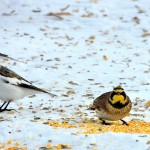
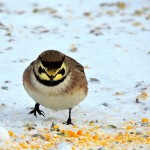
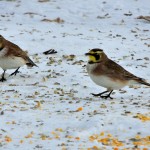
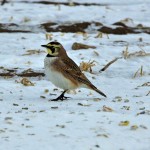
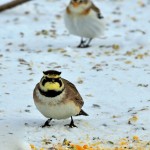
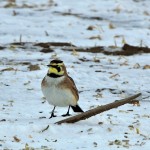
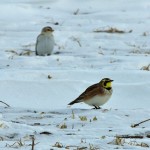
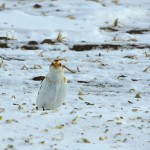
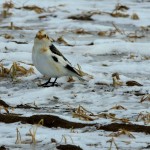
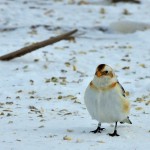
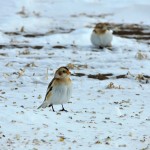
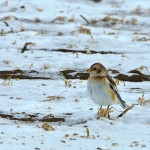
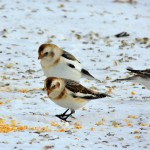
Thanks for enduring the cold for these excellent photos and the details for identifying these delightful birds.